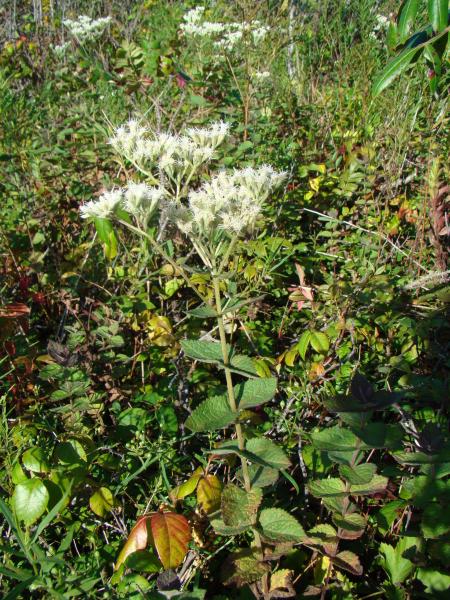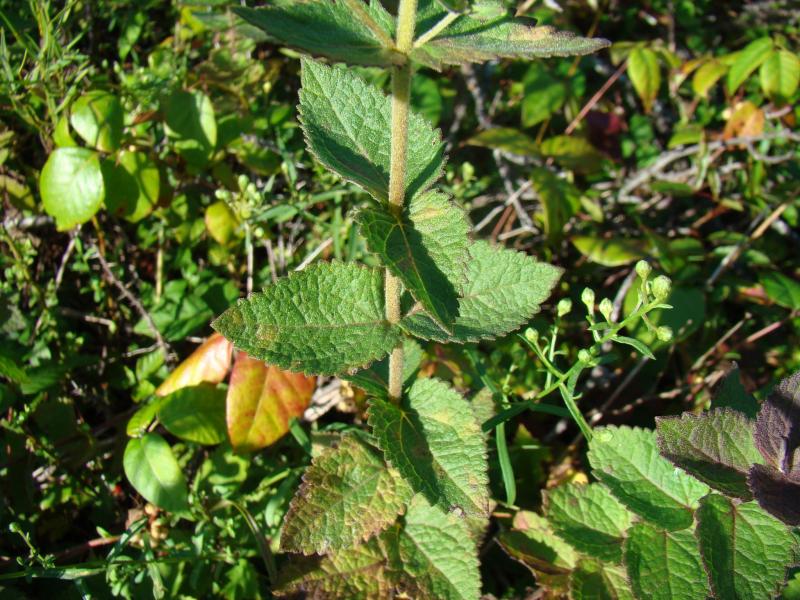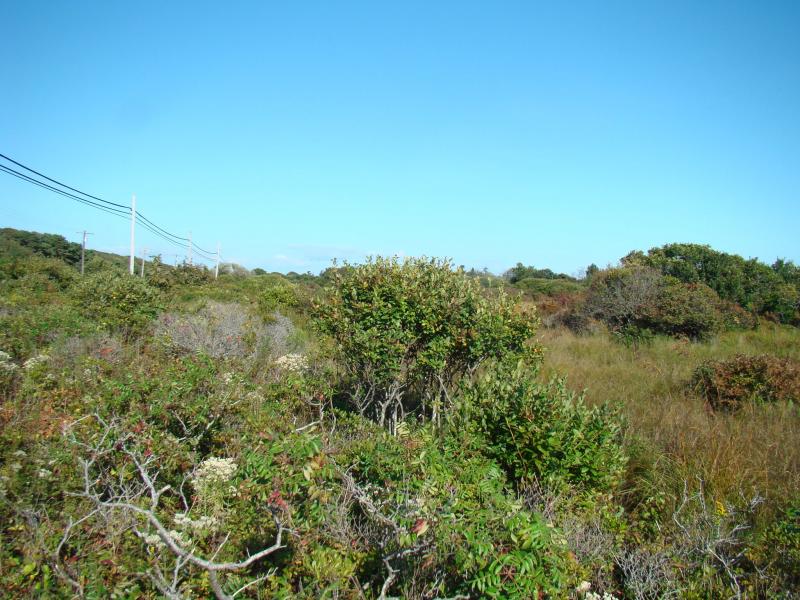Hairy Thoroughwort
Eupatorium pubescens Muhl. ex Willd.
- Class
- Dicotyledoneae (Dicots)
- Family
- Asteraceae (Aster Family)
- State Protection
- Endangered
Listed as Endangered by New York State: in imminent danger of extirpation in New York. For animals, taking, importation, transportation, or possession is prohibited, except under license or permit. For plants, removal or damage without the consent of the landowner is prohibited.
- Federal Protection
- Not Listed
- State Conservation Status Rank
- S1
Critically Imperiled in New York - Especially vulnerable to disappearing from New York due to extreme rarity or other factors; typically 5 or fewer populations or locations in New York, very few individuals, very restricted range, very few remaining acres (or miles of stream), and/or very steep declines.
- Global Conservation Status Rank
- G5T5
Secure globally - Both the species as a whole and the subspecies/variety are common in the world; widespread and abundant (but may be rare in some parts of its range).
Summary
Did you know?
The species name rotundifolium is derived from the Latin "rotund" meaning "round" and "foli(um)" meaning "leaf." The genus name Eupatorium honors Mithridates VI of Pontus (132BC - 63BC), who was also known as Eupator Dionysius (Wikipedia contributors). Eupatorium rotundifolium contains eupatorin acetate, a guaianolide which may have anti-cancer properties, as well as eupachlorin acetate, a related compound which may also inhibit tumors (Wikipedia contributors).
State Ranking Justification
There are five existing populations, but two of them have fewer than 10 plants. There is one other historical occurrence on Staten Island.
Short-term Trends
The larger populations seem stable, although one of them has not been revisited. There is no recent information on the smaller populations, so their trend is unknown.
Long-term Trends
There were only ever a couple of historical populations of this species and one of them was rediscovered. Five additional populations were subsequently discovered.
Conservation and Management
Threats
Some plants occur near phragmites that may eventually encroach on the plants. The populations along roads and power lines are threatened by succession if their open habitat is not maintained, or they are directly impacted by maintenance machines.
Conservation Strategies and Management Practices
This species needs disturbance to reduce competition from woody plants, but too much direct disturbance to the plants will reduce the population. Its habitat could be disturbed in the non-growing season to open it up for seed germination and colonization, but direct disturbance should be prevented during the growing season. Any nearby exotic invasive species need to be controlled.
Habitat
Habitat
In New York, Serrate Round-leaf Boneset has been found growing in open, often moist, sandy ground along roadsides, powerline right-of-ways, and next to interdunal swales and wet depressions (NYNHP 2010). Moist, low ground, roadsides, sandy soils (FNA 2006). Woods, in dry or seldom wet soil (Gleason and Cronquist 1991).
Associated Ecological Communities
- Herbicide-sprayed roadside/pathway*
A narrow strip of low-growing vegetation along the side of a road, or along utility right-of-way corridors (e.g., power lines, telephone lines, gas pipelines) that is maintained by spraying herbicides.
- Maritime beach
(guide)
A community with extremely sparse vegetation that occurs on unstable sand, gravel, or cobble ocean shores above mean high tide, where the shore is modified by storm waves and wind erosion.
- Maritime dunes
(guide)
A community dominated by grasses and low shrubs that occurs on active and stabilized dunes along the Atlantic coast. The composition and structure of the vegetation is variable depending on stability of the dunes, amounts of sand deposition and erosion, and distance from the ocean.
- Maritime freshwater interdunal swales
(guide)
A mosaic of wetlands that occur in low areas between dunes along the Atlantic coast; the low areas (swales) are formed either by blowouts in the dunes that lower the soil surface to groundwater level, or by the seaward extension of dune fields. Water levels fluctuate seasonally and annually. Sedges and herbs are usually the most abundant types of plants. These wetlands may be quite small (less than 0.25 acre).
- Pitch pine-oak forest
(guide)
A mixed forest that typically occurs on well-drained, sandy soils of glacial outwash plains or moraines; it also occurs on thin, rocky soils of ridgetops. The dominant trees are pitch pine mixed with one or more of the following oaks: scarlet oak, white oak, red oak, or black oak.
* probable association but not confirmed.
Associated Species
- Apocynum
- Arctostaphylos uva-ursi (bearberry)
- Eupatorium pilosum (ragged thoroughwort)
- Hudsonia
- Hypericum hypericoides ssp. multicaule
- Juncus canadensis (Canada rush)
- Myrica
- Panicum virgatum (switch grass)
- Phragmites australis ssp. australis
- Pinus rigida (pitch pine)
- Polygonella articulata
- Prunus serotina
- Pycnanthemum muticum (short-toothed mountain-mint)
- Rhus copallinum
- Rubus hispidus (swamp dewberry)
- Solidago
- Toxicodendron radicans
- Vaccinium angustifolium (common lowbush blueberry)
- Vaccinium corymbosum (highbush blueberry)
Range
New York State Distribution
This plant is currently known from Suffolk County on Long Island, with one historical collection from Staten Island and an unconfirmed report from Queens.
Global Distribution
This herb grows throughout the Southeast from Florida to Texas, north to Southern Pennsylvania, and up through Long Island to Southern New England. It is rare only in New York and Pennsylvania.
Identification Comments
General Description
Eupatorium rotundifolium var. ovatum is a perennial herb, 40 to 100+ cm tall. The stems grow singly from rhizomes, are sparsely branched distally, and have tiny hairs. The leaves are sessile or nearly so, mostly opposite (distal sometimes alternate, lateral buds dormant or producing 1 pair of leaves) 3 to 6.0 cm wide and 1 to 2 times as long . The leaf blades are 3-nerved, deltate to orbiculate and broadest near the middle, with wedge-shaped bases, pointed tips and serrate margins, and are hairy and dotted with glands. The infloresence is of discoid flowers only, arranged into corymbiform (flat or round-topped) heads of 5 florets each, the corollas are white and 3-4 mm long, and the calices form pappi of 30-40 bristles 4 to 4.5 mm long. There are 8-10 phyllaries (involucral bracts) in 2 to 3 rows, each 2 to 6 mm long with acute tips, and pubescent and gland-dotted on their outer (abaxial) sides.
Best Life Stage for Proper Identification
Flowers or fruit with leaves and entire stems are needed for identification of this species.
Similar Species
Eupatorium pilosum has leaves 2 to 3 times as wide as long, often with purple leaf bases. Eupatorium rotundifolium var. rotundifolium has leaves 3-nerved from their bases with crenate margins and subtruncate to broadly cuneate bases (in contrast to E. rotundifolium var. ovatum's leaves, which are 3-nerved distally to their bases with serrate margins and broadly cuneate to cuneate bases). E. rotundifolium var. scabratum has narrower leaf blades (2 to 5 cm), broadest near the base.
- Flowering
- Fruiting
The time of year you would expect to find Hairy Thoroughwort flowering and fruiting in New York.
Hairy Thoroughwort Images
Taxonomy
Hairy Thoroughwort
Eupatorium pubescens Muhl. ex Willd.
- Kingdom Plantae
- Phylum Anthophyta
- Class Dicotyledoneae
(Dicots)
- Order Asterales
- Family Asteraceae (Aster Family)
- Order Asterales
- Class Dicotyledoneae
(Dicots)
- Phylum Anthophyta
Additional Common Names
- Round-leaf Boneset
- Serrate Round-leaf Boneset
Synonyms
- Eupatorium rotundifolium var. ovatum (Bigelow) Torr.
Comments on the Classification
This species is hybrid-derived and should not be treated as a variety. It is now treated as a full species.
Additional Resources
Best Identification Reference
Flora of North America Editorial Committee. 2006. Flora of North America North of Mexico. Vol. 21. Magnoliophyta: Asteridae, Part 8: Asteraceae, part 3. Oxford Univ. Press, New York. xxii + 616 pp.
Other References
Fernald, M.L. 1950. Gray's manual of botany. 8th edition. D. Van Nostrand, New York. 1632 pp.
Gleason, Henry A. and A. Cronquist. 1991. Manual of Vascular Plants of Northeastern United States and Adjacent Canada. The New York Botanical Garden, Bronx, New York. 910 pp.
Holmgren, Noel. 1998. The Illustrated Companion to Gleason and Cronquist's Manual. Illustrations of the Vascular Plants of Northeastern United States and Adjacent Canada. The New York Botanical Garden, Bronx, New York.
New York Natural Heritage Program. 2010. Biotics database. New York Natural Heritage Program. New York State Department of Environmental Conservation. Albany, NY.
New York Natural Heritage Program. 2024. New York Natural Heritage Program Databases. Albany, NY.
Weldy, T. and D. Werier. 2010. New York flora atlas. [S.M. Landry, K.N. Campbell, and L.D. Mabe (original application development), Florida Center for Community Design and Research http://www.fccdr.usf.edu/. University of South Florida http://www.usf.edu/]. New York Flora Association http://newyork.plantatlas.usf.edu/, Albany, New York
Links
- Google Images
- NatureServer Explorer
- Nearctica - Eastern Wildflowers
- USDA Plants Database
- Wikipedia contributors. Eupatorium rotundifolium. Wikipedia, The Free Encyclopedia. November 30, 2009. Accessed January 26, 2010.
- Wikipedia contributors. Mithridates VI of Pontus. Wikipedia, The Free Encyclopedia. January 22, 2010. Accessed January 26, 2010.
About This Guide
This guide was authored by: Stephen M. Young
Information for this guide was last updated on: September 6, 2012
Please cite this page as:
New York Natural Heritage Program. 2024.
Online Conservation Guide for
Eupatorium pubescens.
Available from: https://guides.nynhp.org/serrate-round-leaf-boneset/.
Accessed July 26, 2024.


